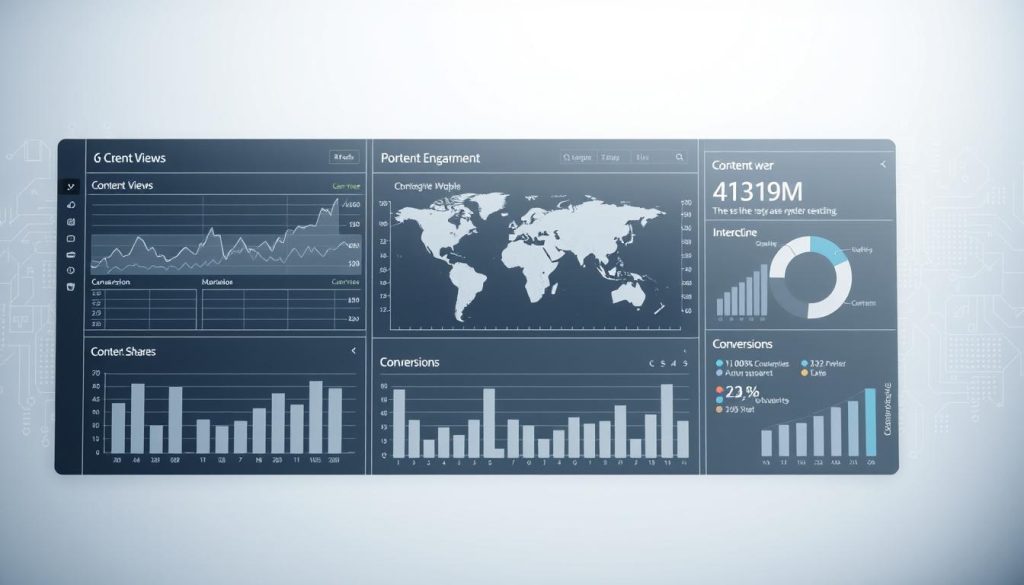Creating great material used to be the main goal for businesses. Today, the digital world has changed dramatically. The real leverage now comes from getting your message seen by the right people.
With millions of blog posts published every day, simply creating something is no longer enough. A smart marketing approach ensures your work doesn’t get lost in the noise. You need a clear plan to reach your target audience effectively.
This shift is crucial for any brand wanting to stand out. The old 80/20 rule has flipped. Now, you should spend more time promoting your work than creating it. This strategic focus separates successful companies from invisible ones.
In today’s crowded online space, content distribution is essential. It’s the process of amplifying your presence by placing your message where people will see it. Without proper distribution, even the best material has little value.
Table of Contents
Key Takeaways
- The focus has shifted from creation to strategic promotion of digital material.
- Effective distribution ensures your message reaches the intended viewers.
- A modern marketing plan dedicates more resources to promotion than creation.
- Without proper distribution, quality work remains unseen by target audiences.
- Strategic placement across channels maximizes impact for your brand.
- The digital landscape requires active promotion to overcome content saturation.
Understanding the Evolution of Content Distribution
What worked for digital visibility five years ago no longer delivers results today. The marketing landscape has transformed completely, moving beyond simple publication strategies.
Shifting from Content Creation to Strategic Distribution
The old « publish more, get seen more » philosophy has collapsed under today’s digital noise. With over 46,000 Instagram posts per minute and 450,000 tweets every sixty seconds, organic reach has become nearly impossible.
More than 800,000 daily blog posts never reach their intended audience due to poor planning. This saturation creates what expert Mark Schaefer calls « content shock, » where supply vastly exceeds human consumption capacity.
The Impact on Online Visibility in Today’s Market
Algorithmic changes on major platforms have shifted power away from organic visibility. Brands now need sophisticated promotion strategies rather than relying on material quality alone.
Even exceptional work can languish unseen without proper planning across multiple channels. This permanent shift requires fundamental restructuring of resources and priorities for successful social media sharing and other distribution methods.
Defining Content Distribution
The journey of your message doesn’t end when you hit ‘publish’—that’s where it truly begins. Content distribution is the systematic process of ensuring your work reaches the people who need to see it.
This strategic approach involves promoting blogs, videos, podcasts, and other formats across the channels your audience frequents. You determine where your material goes, who sees it, and what results you want to achieve.
What is Content Distribution?
Creating material and distributing it represent two distinct functions. The first involves crafting your message, while the second focuses on making sure people actually receive it.
Think of distribution as the bridge connecting your work with your target audience. Without this connection, even the most valuable material remains unseen and unused.
Core Components and Influencing Factors
Every successful distribution strategy relies on two fundamental elements: timing and placement. Timing determines when you release your material for maximum visibility. Placement identifies the right channels where your audience will encounter it.
Several factors influence your distribution success. Audience behavior patterns, platform algorithms, and competitive landscape all play crucial roles. Different formats—from infographics to webinars—require unique approaches across various media.
Effective planning requires considering who will see your work, which channels will deliver it, and how you’ll measure success. This customized approach ensures your material reaches the right eyes at the right moment.
The Strategic Importance of a Content Distribution Strategy
Strategic amplification separates thriving brands from forgotten ones. With over 2.8 million blog posts published daily, nearly 800,000 never reach their intended viewers. This represents billions in wasted marketing investment annually.

A documented approach prevents this waste. It ensures every asset has a clear pathway to achieve measurable business outcomes. This formal plan is essential for competitive positioning.
Overcoming Digital Noise
The fight for visibility is intense. Your material competes with everything online. A clear content distribution strategy creates multiple touchpoints across diverse channels.
This increases the probability that target audiences will encounter your work in their preferred environments. Strategic placement cuts through the digital clutter effectively.
Driving Better ROI and Engagement
Marketers who distribute well see better returns on every asset. Proper planning extends material lifespan and maximizes reach per piece. This improves engagement rates and drives more conversions.
When audiences find you in their inbox, search results, and social platforms, it builds familiarity. This consistency translates into credibility and preference over time.
Each touchpoint reinforces previous ones, building momentum that establishes your brand as an authority. That’s how companies earn attention in today’s crowded market.
Utilizing Smart Channels: Owned, Earned, and Paid Media
The digital landscape offers three distinct routes to reach your audience, each with unique advantages and applications. Understanding these content distribution channels helps brands create comprehensive visibility strategies.
Smart marketers blend all three approaches for maximum impact. This multi-channel strategy ensures your message reaches people through different touchpoints.
Exploring Owned Channels for Long-Term Visibility
Owned media channels include properties you fully control. Your website, blog, and email newsletter fall into this category.
These platforms offer complete creative freedom and build lasting value. They provide direct communication with your audience without ongoing costs.
| Channel Type | Key Features | Advantages | Examples |
|---|---|---|---|
| Owned Media | Brand-controlled properties | No distribution costs, full analytics | Website, blog, email list |
| Earned Media | Third-party validation | High credibility, organic reach | Press mentions, social shares |
| Paid Media | Guaranteed visibility | Rapid scaling, precise targeting | Social ads, influencer partnerships |
Maximizing Earned and Paid Media Benefits
Earned media comes from external recognition of your work. This includes press coverage, customer reviews, and social shares.
These distribution channels carry higher trust because they represent third-party endorsement. They expand your reach to new audiences organically.
The most effective strategies use owned media as foundation, earned media for credibility, and paid media for acceleration.
Paid options like social advertising provide immediate visibility. They work best when amplifying material that already performs well through other channels.
Crafting an Effective Content Distribution Plan
Without a structured blueprint for promotion, even the most valuable digital assets can remain hidden from the audiences who need them most. A well-designed plan transforms random posting into strategic outreach that delivers measurable results.
Setting SMART Goals and KPIs
Begin by defining clear objectives using the SMART framework. Instead of vague aims like « increase visibility, » specify « boost newsletter sign-ups by 25% within three months. » This approach makes every effort measurable and time-bound.
Each goal should connect directly to business outcomes. Track specific metrics that reflect your progress. For awareness campaigns, monitor page views and social shares. Lead generation efforts require conversion rate monitoring.
Auditing and Mapping Your Existing Content
Most organizations possess underutilized material that can be repurposed effectively. Conduct a thorough inventory of all existing assets. Tag each piece by topic, format, and performance history.
Identify high-performing articles that could become videos or podcasts. Transform comprehensive whitepapers into serialized email campaigns. This maximizes return on existing investments without additional creation costs.
| Goal Type | Primary KPI | Secondary Metrics | Timeframe |
|---|---|---|---|
| Brand Awareness | Unique Visitors | Social Shares, Impressions | Monthly |
| Lead Generation | Conversion Rate | Form Completions, CTR | Quarterly |
| Audience Engagement | Time on Page | Comments, Bounce Rate | Weekly |
| Customer Loyalty | Repeat Visits | Newsletter Sign-ups, Shares | Bi-annual |
Tailoring Distribution Strategies to Your Target Audience
Distribution success hinges on one critical element: deep audience insight. You cannot effectively place your material without understanding where your people gather online and what formats they prefer.
Effective promotion requires analyzing both quantitative and qualitative data. Study your analytics to see which channels drive high-intent visitors. Look for longer page visits and deeper engagement.

Understanding Audience Behavior and Preferences
Complement analytics with real-world observations. Monitor LinkedIn discussions, Reddit threads, and niche forums. See what questions your target audience asks before making decisions.
Segment your viewers by their journey stage and role. A CMO consumes material differently than an operations manager. Each segment has unique channel preferences and content needs.
Collect demographic data from your website visitors and email subscribers. Understand their age, location, and professional background. This information helps create accurate audience profiles.
Direct feedback through surveys and interviews reveals pain points. Ask customers about their information needs and format preferences. This ensures your social media sharing and other efforts resonate with real people.
Build detailed buyer personas representing your ideal viewers. Use these profiles to guide channel selection and timing decisions. This evidence-based approach dramatically increases engagement with your target audience.
Leveraging Social Media Channels for Maximum Reach
Social networks have transformed from casual connection tools into powerful business amplifiers. Choosing the right platforms is crucial for reaching your specific audience effectively.
Selecting the Right Social Media Platforms
Not every social media channel suits every business. LinkedIn excels for B2B thought leadership, while Instagram and TikTok capture younger demographics with visual storytelling. Facebook remains strong for community building.
YouTube serves long-form educational needs, and Twitter facilitates real-time industry conversations. Select platforms where your target audience actively engages rather than maintaining presence everywhere.
Scheduling and Repurposing Social Media Posts
Each platform has optimal posting times. LinkedIn peaks during weekday mornings when professionals check feeds. Instagram and TikTok see higher engagement during evening entertainment scrolling.
Use native analytics to determine your audience’s active hours. One core asset can generate multiple social media posts across different platforms. A blog article becomes LinkedIn carousels, Twitter threads, and Instagram stories.
This systematic repurposing maintains consistent presence without overwhelming creation resources. Effective social media sharing adapts messages to platform conventions while maintaining brand consistency.
Balancing Content Creation with Distribution Efforts
The most common pitfall in digital marketing today isn’t poor quality work—it’s the failure to ensure that work reaches its intended audience. Many teams celebrate finishing new material while overlooking the more critical task of promotion.
The 80/20 Rule: Creation vs. Distribution
Traditional approaches often reverse the proper resource allocation. The modern 80/20 principle suggests spending just 20% of your time on creation and 80% on strategic promotion. This shift maximizes impact from every piece produced.
Crafting messages and ensuring they’re heard represent distinct functions. One involves developing the material itself. The other focuses on placement across appropriate channels where your audience actively engages.
| Activity Type | Traditional Allocation | Optimized Approach | Expected Outcome |
|---|---|---|---|
| Material Creation | 70-80% of resources | 20% of total time | High-quality assets |
| Strategic Promotion | 20-30% of effort | 80% of marketing time | Maximum audience reach |
| Performance Analysis | Minimal attention | Integrated throughout | Continuous improvement |
Psychological barriers often maintain this imbalance. Teams enjoy the visible satisfaction of producing new work. They mistakenly believe quality alone ensures discovery.
Successful organizations implement clear protocols for systematic promotion. They establish repurposing templates and schedule promotion cycles. This ensures every asset receives proportional attention.
Applying Data and Analytics to Optimize Performance
Analytics provide the roadmap for continuous improvement, showing which distribution tactics deliver measurable business impact. Without proper measurement, you cannot distinguish between effective strategies and wasted efforts.
Tracking KPIs and Engagement Metrics
Start with Google Analytics to understand traffic patterns and referral sources. Layer in platform-specific tools like LinkedIn Analytics and Meta Business Suite.
Advanced tools like Hotjar reveal how visitors interact with your material. Track scroll depth for articles and completion rates for videos. Match metrics to your specific goals for accurate performance assessment.

Reviewing and Improving Campaign Performance
Establish monthly reviews to compare results against your objectives. Quarterly assessments reveal larger patterns for strategic adjustments.
Systematic A/B testing improves outcomes over time. Experiment with subject lines, thumbnails, and posting schedules. This data-driven approach ensures continuous optimization of your promotional efforts.
Focus on metrics that directly connect to business outcomes. Engagement rates and conversion data provide actionable insights. This transforms your strategy from guesswork to precision.
Incorporating AI Tools into Your Content Distribution Workflow
The integration of AI technology into promotional workflows represents the next evolution in digital marketing efficiency. These intelligent solutions automate repetitive tasks that once consumed valuable team resources.
Automating Repetitive Tasks
AI-powered platforms like Distribution AI and Copy.ai transform single pieces into multiple formats instantly. A comprehensive blog post can become a LinkedIn carousel or video script in seconds.
Text-to-video tools such as HeyGen convert articles into engaging explainer videos. Descript and Opus Clip edit long recordings into social-ready clips with automated captions.
Optimizing Timing and Personalization
Intelligent tools analyze behavioral data to predict optimal posting times. Platforms like CoSchedule identify when specific audience segments are most active.
AI enables sophisticated personalization at scale. Marketers can create multiple variations from one core message, tailoring communications for different roles and industries. This approach enhances your social media sharing effectiveness dramatically.
Best Practices for Multichannel Content Reach
A well-orchestrated multichannel approach ensures your message resonates wherever your audience gathers. This coordination prevents disjointed experiences and builds cohesive brand recognition across platforms.
Maintaining a Consistent Content Calendar
Your promotional calendar sets the rhythm for all outreach activities. Choose core social media channels and establish realistic posting frequencies for each platform.
LinkedIn typically performs best during weekday mornings. Instagram and TikTok see higher engagement during evening hours. Consistency matters more than overwhelming frequency when resources are limited.
Partnering with Influencers and Using Earned Media
Select creators who genuinely connect with your target demographic. Relevance often outweighs raw follower counts in driving meaningful engagement.
Start with smaller collaborations like co-created blogs or joint newsletters. Research confirms that 88% of consumers trust word-of-mouth recommendations, making earned media incredibly valuable for expanding your reach.
Track performance data from each partnership to refine future collaborations. This strategic approach builds authentic connections rather than transactional relationships.
Case Studies: Successful Content Distribution Strategies
Industry leaders provide valuable insights through their documented promotional victories across diverse platforms. These real-world examples demonstrate how strategic approaches deliver measurable results.
Real-life Examples of High-Impact Campaigns
HubSpot’s experience with Reddit advertising offers a compelling case study. The marketing team discovered that paid ads performed significantly better when combined with authentic organic engagement.
They actively participated in relevant subreddit communities while running targeted advertisements. This blended approach of paid and earned media created genuine connections with their audience.

Key Lessons Learned from Industry Leaders
Successful organizations consistently follow platform-specific guidelines. They optimize posting times and adapt messaging for each channel’s unique audience.
Most effective campaigns combine multiple approaches rather than relying on single channels. Testing before scaling ensures resources are allocated efficiently.
| Company | Strategy Used | Key Result | Primary Lesson |
|---|---|---|---|
| HubSpot | Reddit paid/organic blend | Higher engagement rates | Authenticity boosts paid performance |
| B2B Tech Firm | LinkedIn thought leadership | 45% lead increase | Platform specialization matters |
| Consumer Brand | Multi-format repurposing | 3x content lifespan | Consistency builds momentum |
| Educational Institution | Email sequence strategy | 28% conversion boost | Timing optimization critical |
Key Considerations for 2025 and Beyond
Forward-thinking organizations must adapt to emerging trends that will define promotional success in coming years. The digital environment continues evolving rapidly.
Emerging Trends in Content Distribution
Consumer skepticism is reshaping marketing approaches. Only 8% of people automatically trust advertisements. This requires more authentic connection methods.
Influencer partnerships are maturing beyond simple sponsorships. Brands will spend $15 billion on these collaborations. Long-term relationships build genuine audience trust.
| Emerging Trend | Impact on Strategy | Required Adaptation |
|---|---|---|
| AI Content Proliferation | Increased competition for attention | Focus on unique value and authenticity |
| Privacy Regulations | Reduced targeting capabilities | Build first-party data relationships |
| Short-form Video Dominance | New platform opportunities | Develop video creation skills |
| Ad Blocker Usage (42%) | Traditional ads less effective | Emphasize owned and earned media |
The most successful organizations will be those that build flexibility into their core approach, allowing for quick adaptation as new platforms and consumer behaviors emerge.
Preparing Your Strategy for Future Changes
Successful marketing requires constant evolution. Allocate time for testing new channels regularly. Monitor platform algorithm updates closely.
Build mechanisms for rapid resource reallocation. Consumer attention spans continue shrinking. Your strategy must remain agile and responsive.
Optimizing « Content Distribution » Across Channels
Successful audience outreach requires careful coordination across multiple platforms. This final integration brings together all strategic elements into a cohesive promotional system.
Integrating Content Marketing with Distribution Strategy
Effective promotional planning starts before creation begins. Your marketing strategy should outline clear pathways for each piece. This ensures every asset has predefined success metrics.
Team alignment is crucial for seamless execution. Coordinate efforts across creators, social managers, and email specialists. Unified goals prevent disjointed promotional activities.
Aligning Your Branding with Channel Strengths
Each platform serves different audience needs. LinkedIn excels for professional insights while Instagram favors visual storytelling. Match your material types to channel strengths.
Owned channels form your promotional foundation. Your website, blog, and newsletter build lasting value. These assets remain under your complete control.
Maintain consistent brand identity while respecting platform conventions. This approach ensures recognition without appearing disconnected from each channel’s culture.
Conclusion
Many organizations possess excellent assets but struggle with the systems needed to amplify their reach effectively. The real challenge isn’t creating more material—it’s building processes that ensure your existing work reaches the right people.
Start by conducting a thorough audit of your current approach. Identify what’s working and eliminate ineffective methods. Then implement one repeatable system that streamlines your efforts.
Focus on manageable improvements rather than complete overhauls. Optimize one channel or establish a simple repurposing workflow. These incremental wins build momentum for lasting success.
Remember that strategic social sharing requires ongoing attention and adaptation. Monitor performance regularly and adjust your approach based on real results.
Your organization likely has valuable material waiting to be discovered. With the right systems in place, you can transform hidden assets into meaningful business outcomes.
FAQ
What is the main goal of a content distribution strategy?
The primary aim is to amplify your message and increase brand visibility. A smart plan ensures your blog posts, videos, and other assets reach the right people on the platforms they use. This drives traffic, engagement, and better results for your marketing efforts.
How do I choose the best social media channels for my brand?
Start by understanding your target audience. Identify where they spend time online and what types of media they consume. For example, LinkedIn is great for B2B, while TikTok appeals to a younger demographic. Align your platform selection with your audience’s behavior and your business goals.
What is the difference between owned, earned, and paid media?
Owned media includes channels you control, like your website and email list. Earned media is publicity gained through word-of-mouth, shares, or press mentions. Paid media involves advertising, such as social media ads or sponsored posts. A balanced strategy uses all three to maximize reach.
How much time should I spend on distribution versus creation?
Many experts recommend following the 80/20 rule. Spend about 20% of your resources on creating high-quality assets. Dedicate the remaining 80% to promoting that material across various channels. This balance helps ensure your work gets seen by your intended audience.
What tools can help automate and optimize my distribution workflow?
Platforms like Hootsuite and Buffer are excellent for scheduling social media posts. AI tools can assist with personalization and optimal timing. Analytics tools, such as Google Analytics, help track performance metrics like traffic and engagement to refine your approach.
Why is a content calendar important for a multichannel strategy?
A consistent calendar keeps your efforts organized and ensures a steady flow of media posts. It helps you plan ahead, maintain a regular posting schedule, and coordinate campaigns across different platforms. This organization is key to sustaining audience interest and reach.
How can I measure the success of my distribution efforts?
Track key performance indicators (KPIs) that align with your goals. Important metrics include website traffic, social media engagement rates, click-through rates, and conversion rates. Regularly reviewing this data allows you to see what’s working and make improvements.
What are some emerging trends in content distribution for the future?
Personalization and interactive media are becoming increasingly important. Short-form video continues to dominate on platforms like Instagram Reels and YouTube Shorts. Also, leveraging influencer partnerships and optimizing for voice search are key considerations for future strategies.





